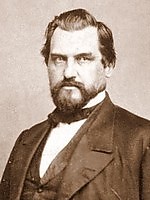|
| Affiliation | Republican |

|
| |
1867-01-01 |
|
|
| Name | Leland Stanford |
| Address |
Palo Alto, California , United States |
| Email | None |
| Website | None |
| Born |
March 09, 1824
|
| Died | June 21, 1893
(69 years)
|
| Contributor | RP |
| Last Modifed | BrentinCO
Jun 10, 2023 06:07pm |
| Tags |
|
| Info | US Senator, 8th Governor of California, Entrepreneur. He received national recognition as the first Republican governor of California, serving from 1862 to 1863. While in office, he started colleges, had the two-year gubernatorial term change to four, cut the state's debt in half and advocated for the conservation of forests. He signed a law to protect Native Americans from being enslaved, yet he continued persecution of the Native Americans in the Bald Hills War. He made anti-Chinese remarks in a speech. He served in the United States Senate from 1885 until his death. During this time, he served as the second chairman of the U.S. Senate Committee on Public Buildings and Grounds and on the Naval Committee. He fostered two bills that never got out of the committees. Besides being in politics, he had other achievements including being the founder of Stanford University and many industrial interests. Born Amasa Leland Stanford, into affluent circumstances, he attended school until adolescence before being tutored at home in his teens. In his later teens he attended Clinton Liberal Institute and Cazenovia Seminary in New York State. On completion of his studies at these institutions, he became a clerk in the Albany law firm of Wheaton, Doolittle and Hadley, being admitted to the bar in 1848. He then moved to Port Washington, Wisconsin to start his own practice. His practice was successful but, in 1852, his offices and library were destroyed by fire. He traveled to northern California alone via the Isthmus of Panama, where he joined his five brothers who had become prosperous merchants selling equipment to gold miners. Within three years in 1855, he was able to purchase his brothers' holdings, returning east for his wife, who had been living with her parents. Settling in California, he entered local politics as a Republican, first as a Justice of the Peace, followed by unsuccessful campaigns for state treasurer in 1857 and governor in 1859. He was elected to the office of governor two years later when the Democratic vote was split between unionist and secessionist factions. He played a significant role in keeping California in the Union during the American Civil War. In Stanford's day "conflict of interest" was an unknown concept in American public life, so despite being governor, he still pursued his private business affairs. He was one of the "Big Four," with Mark Hopkins, Collis Huntington and Charles Crocker, who planned to build the eastbound section of the planned transcontinental railroad. To this end, his position as governor allowed him to secure huge investment funds and land grants from the state to further the project. After retiring from the governorship in 1863, Stanford became president of the Central Pacific Railroad. He held this post until his death. He also was a major shareholder and president of the Southern Pacific Railroad and invested in a number of construction companies engaged in railroad construction. Notably, in 1869, the eastbound Central Pacific and westbound Union Pacific railroads met at Promontory, Utah, completing the transcontinental railroad. Stanford was present at the ceremony and is reputed to have swung the silver sledge hammer that drove in the golden spike to complete the connection of the lines. Stanford became hugely wealthy due to his involvement in the booming railroad industry. He built a mansion in San Francisco, operated 55,000 acres of vineyards, and owned a horse-raising ranch in Palo Alto. The horse farm was the land used for Stanford University. After relocating to San Francisco, he started the Occidental and Oriental Steamship Company, a steamship line to Japan and China. He started Pacific Mutual Life Insurance Company, which is now the successful Pacific Life, serving as the company's first president from 1868 to 1876. Stanford was a director of Wells Fargo and Company from 1870 to January 1884. In 1884, on a trip to Europe, his only child, Leland Stanford Jr, contracted typhoid fever and died at the age of 15. It prompted Stanford and his wife to found and endow a university in his son's memory. Stanford University, near Palo Alto, opened in 1891 and is now one of the world's leading universities. After suffering from a progressive degeneration of the nervous system, locomotor ataxia, he died from heart failure. As his widow, Jane Stanford helped to manage Stanford University. Twelve years later, his wife died by strychnine poisoning, which remains an unsolved murder mystery.
[Link] |
 | BOOKS |
 |
|
| Title |
Purchase |
Contributor |
|
| Start Date |
End Date |
Type |
Title |
Contributor |
|
| Date |
Category |
Headline |
Article |
Contributor |
|
|

